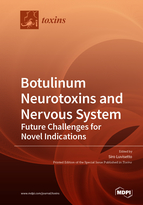Botulinum Neurotoxins and Nervous System: Future Challenges for Novel Indications
A special issue of Toxins (ISSN 2072-6651). This special issue belongs to the section "Bacterial Toxins".
Deadline for manuscript submissions: closed (31 March 2018) | Viewed by 150227
Special Issue Editor
Interests: botulinum neurotoxins; neuropathic pain; peripheral nerve; motor function; functional recovery; animal model; glial cells; Schwann cells
Special Issues, Collections and Topics in MDPI journals
Special Issue Information
Dear Colleagues,
Botulinum toxins (BoNTs) are a true wonder of nature. Like Dr. Jekyll and Mr Hide, they have a double "personality" that makes them unique among toxins of bacterial origin. On the one hand, BoNTs are key components of several widely-used drugs, approved for a variety of clinical conditions, difficult to treat with other medicine. On the other hand, BoNTs are the causal agent of botulism and, with its highest toxicity among natural products, are one of the most dangerous bioterrorism agents. Both animal and clinical studies have extensively investigated the therapeutics effects for BoNTs, evidencing a variety of apparently different mechanisms which have in common the block of the cholinergic transmission at the neuromuscular junction. This discovery gave an extraordinary consensus to the clinical use of BoNTs in human pathologies characterized by excessive muscle contractions, i.e., the hypercholinergic dysfunctions going from torticollis, blepharospasms, dystonias, and so on. In recent years, a number of studies have provided evidence for the efficacy of BoNTs in alleviating human pain, including pain disorders associated with migraine. The list of human disorders in which treatments with BoNTs have produced, or are expected to produce, favorable results is long and continuously growing. This Special Issue “Botulinum Neurotoxins in Nervous System: Future Challenges for Novel Indications” is particularly devoted to collecting the most recent research on the effects of BoNTs in all cases where the expected therapeutic action is not attributable only to the its canonical mechanism, but also to the interaction of the toxins with other structures, including peripheral nerves, spinal cord, central neurons, non-neural cells, and so on. Both review and research articles are welcome, not only on animal studies, but also on clinical reports. The ambitious purpose of this Special Issue is to provide an up-to-date picture of the state-of-the-art on the possible development of novel BoNT applications for future therapeutic indications.
Dr. Siro Luvisetto
Guest Editor
Manuscript Submission Information
Manuscripts should be submitted online at www.mdpi.com by registering and logging in to this website. Once you are registered, click here to go to the submission form. Manuscripts can be submitted until the deadline. All submissions that pass pre-check are peer-reviewed. Accepted papers will be published continuously in the journal (as soon as accepted) and will be listed together on the special issue website. Research articles, review articles as well as short communications are invited. For planned papers, a title and short abstract (about 100 words) can be sent to the Editorial Office for announcement on this website.
Submitted manuscripts should not have been published previously, nor be under consideration for publication elsewhere (except conference proceedings papers). All manuscripts are thoroughly refereed through a double-blind peer-review process. A guide for authors and other relevant information for submission of manuscripts is available on the Instructions for Authors page. Toxins is an international peer-reviewed open access monthly journal published by MDPI.
Please visit the Instructions for Authors page before submitting a manuscript. The Article Processing Charge (APC) for publication in this open access journal is 2700 CHF (Swiss Francs). Submitted papers should be well formatted and use good English. Authors may use MDPI's English editing service prior to publication or during author revisions.
Keywords
- Botulinum
- Peripheral nervous system
- Central nervous system
- Sensory motor system
- Nerve regeneration
- Spinal cord
- Glial cells
- Animal models
- Clinical studies







